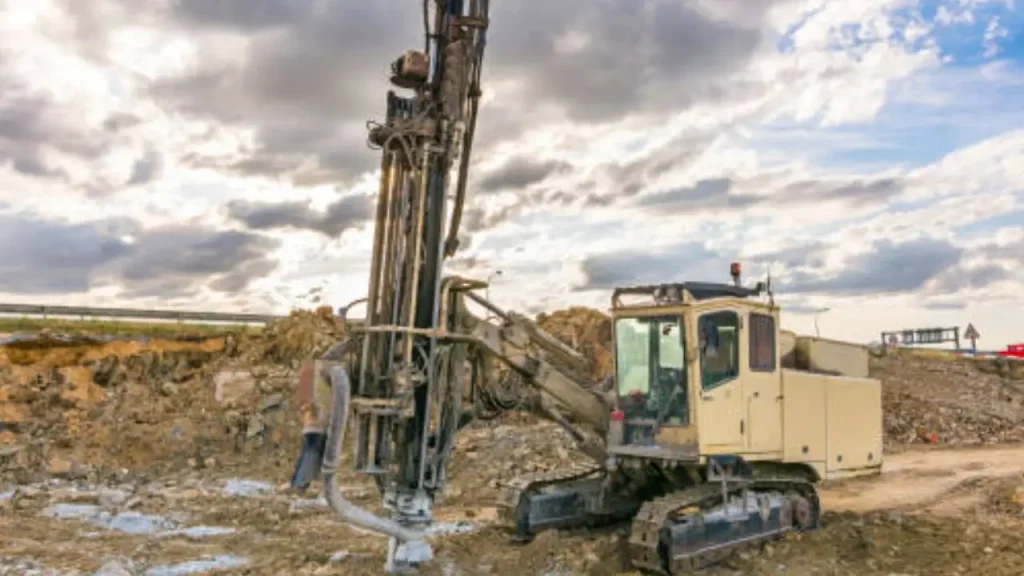Choosing the right geotechnical drilling equipment is crucial for the success of any ground investigation or construction project. The right tools ensure safety, efficiency, and accuracy, providing the critical data needed for informed decisions. This guide will walk you through the key factors to consider when selecting your equipment, ensuring you’re prepared for any project.
From soil sampling to rock coring, a vast array of tools exists, each designed for specific geological conditions. Selecting the best tools for your project’s unique demands can be challenging. By understanding the different types of equipment and their applications, you can optimize your operations and achieve reliable results every time.
What is Geotechnical Drilling?
Geotechnical drilling is a specialized process used to investigate and characterize the subsurface conditions of a potential construction site. It is a fundamental part of a geotechnical investigation, which helps engineers and geologists gather critical information about the soil, rock, and groundwater layers beneath the surface.
The main purpose of this drilling is to determine the ground’s suitability for a proposed structure, such as a building, bridge, or road. By extracting soil and rock samples and performing in-situ tests, geotechnical drilling provides the data necessary to evaluate factors like soil stability, strength, and load-bearing capacity, ensuring the final design is safe, durable, and cost-effective.
What Geotechnical Drilling Equipment Includes?
Geotechnical drilling equipment encompasses a wide range of specialized tools and machinery, each designed to perform specific tasks in ground investigation. From powerful drill rigs to specialized samplers and drill bits, these components work together to provide engineers with critical data about subsurface conditions.
Drill Rigs
Drill rigs are the powerhouses of geotechnical drilling. They’re large, robust machines that provide the necessary force and rotation to advance the drill string into the ground. They are categorized based on their mobility and power source, with common types including truck-mounted, track-mounted, and portable rigs.
Truck-mounted rigs offer high mobility for projects across multiple sites, while track-mounted rigs provide excellent traction and stability on uneven terrain. Portable rigs, which are often tripod-style, are ideal for remote or difficult-to-access locations. The rig’s power system drives a hydraulic or mechanical system that rotates the drill string and applies downward pressure, or “pull-down,” to achieve the desired drilling depth.
Drill Rods
Drill rods are the long, tubular steel sections that connect the drill rig to the drilling tool at the bottom of the borehole. Their primary function is to transmit torque, downward force, and flushing fluids (like water or air) from the rig to the drill bit. There are several types of drill rods, each suited for different drilling methods.
Auger rods are used for shallow drilling in soft soils, where the helical flights on the rod itself remove cuttings. Core barrels are a type of drill rod that houses a core catcher and is used specifically for collecting intact rock samples. For deeper drilling in rock, drill pipes are used, which are hollow and have threaded connections to form a long, continuous drill string. The strength and rigidity of these rods are crucial for maintaining a straight borehole.
Samplers
Samplers are specialized tools designed to collect undisturbed or disturbed soil and rock samples from the subsurface. The type of sampler used depends on the soil or rock type and the desired level of sample integrity. Shelby tubes are thin-walled steel tubes pushed into soft, cohesive soils to collect undisturbed samples, preserving the soil’s structure.
Split-spoon samplers are a two-part sampler used to collect disturbed samples, and they are integral to the Standard Penetration Test (SPT), which measures soil resistance. Other samplers, like piston samplers, are used for very soft clays, while core barrels with inner tubes are used to obtain intact rock cores. The quality of the sample directly affects the accuracy of laboratory tests, making the choice of sampler critical for reliable data.
Core Barrels
Core barrels are cylindrical tools that attach to the end of the drill string and are specifically designed to retrieve cylindrical rock samples, known as cores. They are essential for geotechnical investigations in rock, as the core provides a continuous cross-section of the rock formation. The core barrel consists of an outer barrel and an inner barrel.
The outer barrel rotates, cutting the rock with a diamond or tungsten carbide bit, while the inner barrel remains relatively stationary to protect the core from rotational friction. There are various types, including single, double, and triple tube core barrels. The triple-tube variety is used to collect very fragile or fractured rock samples, as it includes a third inner tube that further protects the core.
Drill Bits
Drill bits are the cutting tools at the very end of the drill string, responsible for breaking and penetrating the ground. The bit’s design and material are chosen based on the hardness and abrasiveness of the material being drilled.
Tricone bits feature three rotating cones with teeth or inserts, making them effective for drilling in medium to hard rock and heterogeneous formations. Diamond core bits are impregnated with industrial diamonds and are the standard for coring in very hard rock formations. For drilling in softer rock like shale or sandstone, PDC (Polycrystalline Diamond Compact) bits are highly efficient. The bit’s design is critical for optimizing penetration rate and ensuring the integrity of the borehole.
Casing
Casing is a steel or PVC pipe inserted into the borehole to maintain its stability and prevent it from collapsing. It is typically used in areas with unstable ground, such as loose sand, gravel, or fractured rock. The casing provides a protective wall, allowing for the retrieval of drilling tools, samples, and the performance of in-situ tests without the risk of the borehole caving in.
Casing can also be used to seal off groundwater zones, ensuring that drilling fluids are not lost and that the borehole remains open for a prolonged period. The use of casing is vital for ensuring the safety of the drilling operation and the integrity of the collected data.
What Equipment is Needed for Oil Drilling?

Oil drilling requires a complex system of interconnected equipment, most of which is housed within a drilling rig. The primary purpose of this machinery is to bore a well deep into the earth, control the flow of fluids, and ensure safety throughout the process. The equipment can be broken down into several key systems.
Hoisting and Rotating Systems
The hoisting system is responsible for lifting and lowering the drill string—a series of connected pipes—into and out of the well. It includes the derrick, a tall, tower-like structure that supports the weight of the drill string, and a drawworks, which is a powerful winch used to reel in and out the drilling line. The rotating system, powered by either a rotary table or a top drive, provides the torque needed to spin the drill string and the bit at its end. The drill string itself is composed of drill pipe and drill collars which add weight to the bit to help it cut through rock.
Circulation System
The circulation system is essential for cooling the drill bit and removing rock cuttings from the wellbore. The main components are mud pumps, which circulate a specialized fluid called drilling mud down the drill pipe. This mud then returns to the surface through the space between the drill pipe and the borehole wall (annulus), carrying rock cuttings with it. Other equipment, such as shale shakers and degassers, then separates the cuttings and gases from the mud so it can be recycled.
Pressure Control and Safety Systems
Safety is paramount in oil drilling, and equipment is in place to prevent a blowout—an uncontrolled release of oil and gas. The most critical piece of safety equipment is the blowout preventer (BOP) . This is a large, high-pressure valve system installed at the wellhead that can seal the wellbore if a sudden pressure increase occurs. Casing, which are large-diameter pipes cemented into the well, also helps to stabilize the borehole and prevent blowouts.
Well Completion Equipment
Once drilling is complete and a reservoir has been reached, the well needs to be prepared for production. This involves installing equipment like casing and tubing. The casing provides structural integrity, while the tubing is a smaller-diameter pipe used to bring the oil or gas from the reservoir to the surface.
Geotechnical Drilling Methods
Geotechnical drilling involves several methods, each selected based on the specific ground conditions and project objectives. The primary goal is to retrieve high-quality samples and conduct in-situ tests to assess soil and rock properties. Rotary drilling is a common method that uses a rotating drill bit to cut into the ground, often with the help of drilling fluids to cool the bit and remove cuttings.
Auger drilling uses a helical flight to both cut and transport soil to the surface without the need for fluids, making it ideal for shallow, soft ground. Percussion drilling, which includes Down-the-Hole (DTH) and top-hammer methods, uses a percussive hammer action to break hard rock. The choice of method is critical for obtaining accurate data and ensuring project safety.
- Rotary Drilling: Best for a wide range of materials, from soil to hard rock, using a rotating action.
- Auger Drilling: Efficient for shallow holes in soft, cohesive soils and sands above the water table.
- Percussion Drilling: Ideal for hard rock formations, relying on a hammer action to break through difficult ground.
- Sonic Drilling: A specialized, high-frequency vibratory method that minimizes disturbance and is excellent for collecting continuous core samples.
How to Choose Suitable Geotechnical Drilling Equipment
Choosing the right geotechnical drilling equipment is crucial for a project’s success, safety, and cost-effectiveness. The selection process should be a strategic decision based on the specific requirements of the job. You need to consider the type of soil or rock you’ll be drilling through, the required depth of the boreholes, and the purpose of the investigation, whether it’s for foundation design, environmental sampling, or mineral exploration. Additionally, logistical factors like site accessibility and budget constraints will influence your choice. Selecting the most appropriate tools and machinery ensures that you can efficiently collect accurate data while minimizing downtime and operational costs.
- Geological Conditions: Match your equipment to the ground. For soft soils, augers and samplers are ideal, while rotary and core drilling are necessary for hard rock.
- Project Depth and Scope: Deeper investigations require more powerful drill rigs and sturdier drill rods, whereas shallow projects can often use smaller, portable equipment.
- Purpose of Investigation: The equipment you choose depends on what you need to find. If you need undisturbed soil samples, you’ll need a Shelby tube or piston sampler. If you’re looking for rock cores, you’ll need a core barrel.
- Logistics and Budget: Consider site accessibility and your budget. Smaller, portable rigs are better for tight spaces, while a larger budget might allow for more advanced, efficient equipment.
Conclusion
Selecting the right geotechnical drilling equipment is a critical investment that impacts project outcomes, safety, and budget. By carefully assessing your specific needs—including geological conditions, project scale, and required data—you can make an informed choice. Remember, high-quality, reliable equipment is the foundation of a successful and safe drilling operation.
Investing in the right tools will not only enhance your operational efficiency but also provide long-term cost savings by reducing downtime and maintenance. The durability and precision of professional-grade equipment ensure that every test and sample you collect is accurate and dependable. This is the key to building strong, secure foundations.
For all your geotechnical drilling needs, trust Sinodrills. We offer a wide range of wholesale geotechnical tools, from drill rods and bits to soil sampling equipment. Our high-quality products are designed for durability and performance, helping you complete your projects with confidence. Contact us today to get the reliable tools you need.


